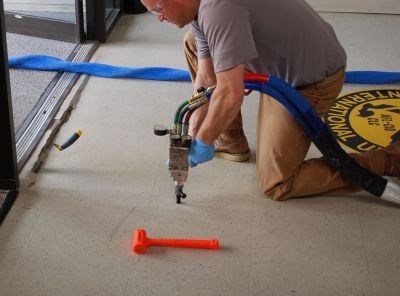
Learn how long you can expect polyjacking to keep your concrete level.
Foam concrete leveling is usually the most expensive concrete leveling method out there. But does the higher price tag mean that it will last longer than the other concrete leveling options?
The short answer is no – polyjacking can last for the life of your concrete, just like stone slurry grout leveling or mudjacking.
But the long answer is a little more complicated than that, which is why we’re breaking it down for you in this article.

How Long Does Polyjacking Last?
Foam concrete lifting can last for the lifetime of the concrete itself, which can be 20 to 50+ years.
But whether or not it lasts this long depends on whether it was done correctly in the first place and regularly maintained after the fact (more on this in the next sections).
Why Does Foam Concrete Lifting Last So Long?
Many people think that because the foam is waterproof, or because the foam reacts chemically with the soil underneath the concrete slab, it makes foam stick around longer than other concrete leveling methods.
Not only are these two ideas common polyjacking myths, but all concrete leveling methods, if done correctly and regularly maintained after the fact, can last the lifetime of the concrete itself – not just foam.
How Can Foam Leveling Be Done Correctly?
The reason concrete settles in the first place is because the soil underneath naturally settles over time, or because the soil erodes away.
But as long as the soil has had the proper time to compact and there is no erosion taking place, the concrete leveling job should stay in place.
Whether or not a foam concrete lifting repair is done correctly depends on whether the crew determines that the soil has finished settling naturally and won’t continue to sink, and finds (and eliminates) any sources of soil erosion, like direct water flow or burrowing pests.
Related Resource: Why Concrete Leveling Repairs Fail
What Causes Foam Concrete Lifting To Fail?
While concrete lifted with foam can last for the life of your concrete, there are some additional things to consider that may make it less durable, beyond what’s been mentioned in the section above:
-
Improper Void Fill
The nature of expanding foam can make it challenging to entirely fill all voids under the slab. This process can result in concentrated material pillars (or "pancake stacks") beneath the concrete which put unnecessary stress on the unsupported parts of the concrete, risking additional cracking.
These pillars also create open gaps under the slab, making it easier for water to pass through and erode the soil away, which can cause the slab to resettle.
-
Lower Compressive Strength
The foam material used for lifting the slab isn’t as strong as mudjacking or stone slurry grout leveling repairs on its own, but when considering the difficulty in filling all voids below the slab, it can lead to an even weaker repair.
This is a problem for weight-bearing areas, as the foam or concrete may give way under heavy loads, ruining both the concrete and the repair.
-
Pest Infestations
It’s possible that pests like ants can burrow in the foam, causing perforations and tunnels throughout what is supposed to be holding up the slab. These burrows can cause the foam to weaken over time and the concrete to resettle.
-
UV Exposure
Polyurethane foam is susceptible to UV rays and can degrade if exposed to sunlight. As long as the foam is covered under the concrete, this won’t be an issue, but if the foam is left exposed along the sides and sunlight hits it, then it can break down and cause the repair to fail.
Maintaining Foam Concrete Lifting Repairs
A big part of how long any concrete leveling repair lasts – polyjacking, stone slurry grout leveling, and mudjacking alike – is how well it's maintained after the repair is complete.
Here are some of the important maintenance practices that will help prevent soil erosion and keep your concrete in the right position:
- Prevent and manage burrowing pest infestations
- Fix leaky or clogged gutters
- Redirect downspout or drainage flow away from concrete
- Keep soil or landscaping levels even with the surface of the slab
- Caulk cracks and joints to reduce water flow below slabs
Related Resource: How To Maintain Your Concrete Leveling Repair
Foam Concrete Lifting Alternatives
As mentioned above, all concrete leveling methods have the potential to last for the life of the concrete slab itself. And each of these methods comes with its own set of pros and cons.
While we offer polyjacking services in some of our A-1 locations, we want you to be aware of all the options available to you so you can make the best decision for your concrete.
-
Stone Slurry Grout Leveling
Stone slurry grout leveling is a concrete lifting method that uses a controlled speed and pressure to pump a limestone slurry under settled slabs to gradually lift them back up to the proper position.
Related Resource: The Pros and Cons of Stone Slurry Grout Concrete Leveling
-
Mudjacking
Mudjacking works by pumping a mixture of soil, sand, and water under the slab at a high speed and pressure to lift it back up. “Mudjacking” is commonly used as an umbrella term to mean “concrete leveling” as a whole, but it’s really a standalone method.
Related Resource: The Pros and Cons of Mudjacking
Should You Polyjack Your Concrete?
When done correctly, foam concrete lifting can stick around for the life of your concrete, but like anything else, it’s important to weigh all the pros and cons and get expert opinions before deciding the right option for you.
To compare all three types of concrete leveling side by side, check out this resource: The Types of Concrete Leveling Compared
Here at A-1 Concrete Leveling, we offer foam concrete lifting in some of our nationwide locations, and stone slurry grout leveling in all of them. If you’d like to see what either of these services can do for your concrete, click the link below to request a free onsite cost estimate:
Click Here to Find Your Nearest Location and Receive a FREE Estimate
Sarah Etler joined A-1 Concrete Leveling after receiving her Bachelor of Arts degree in English from Northern Kentucky University. As A-1's Content Marketing Manager, she works closely with industry experts to produce content that will best answer questions related to concrete repair and maintenance practices. Sarah loves living a life full of discovery and is excited every day to see what new things she can learn and share with those around her.